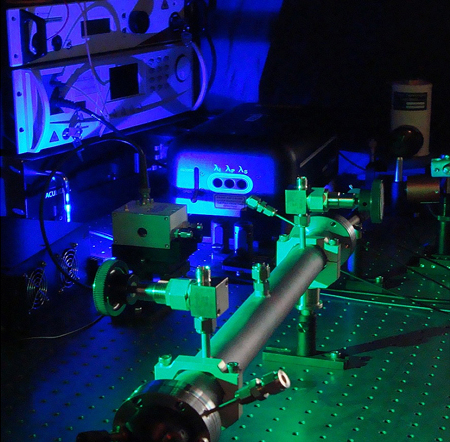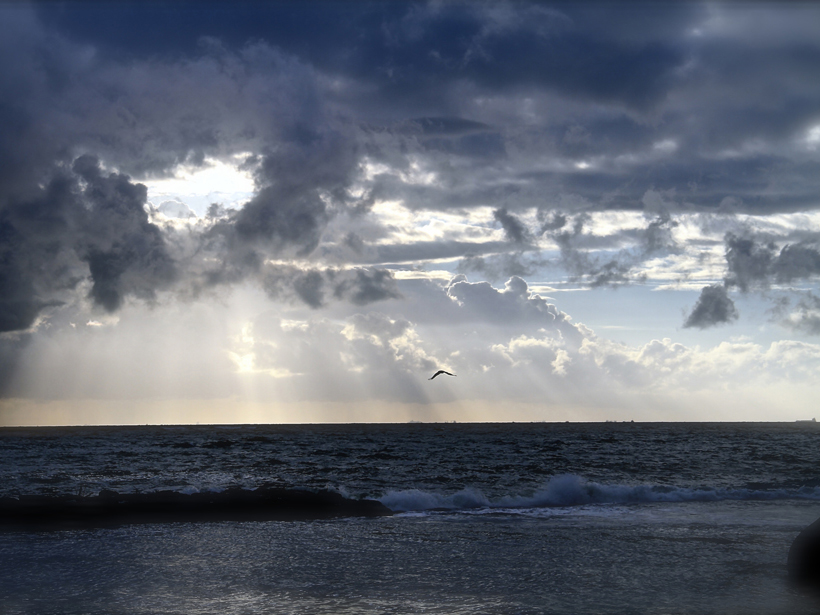Understanding biogeochemical cycles in the context of global change requires us to understand and quantify the oceanic pathways and ocean-atmosphere exchange of climate-relevant trace gases, including carbon dioxide (CO2), nitrous oxide (N2O), and methane (CH4).

Absorption spectroscopy offers precise, accurate, and fast measurement capabilities that are a prerequisite for determining trace gas concentrations on small temporal and spatial scales. Cavity-enhanced absorption spectroscopy (CEAS) uses highly reflective mirrors at each end of a measurement cell in a resonant configuration to significantly extend the effective absorption path lengths to several kilometers (see photo). This enables us to detect gases at very low ambient concentrations.
In April 2015, more than 30 scientists from Australia, Canada, Denmark, Germany, the United Kingdom, and the United States came together for a 2-day workshop at Kiel University in Germany to review the progress in CEAS and to discuss future perspectives of this method in marine sciences.
Marine applications of CEAS have increased quickly since the first publication on the topic in 2010: CEAS-based instruments coupled to continuous seawater-gas equilibrators are now used frequently to determine dissolved trace gases (N2O, CH4, CO2, carbon monoxide, and carbonyl sulfide) from the surface layers of the open and coastal oceans.
Marine applications of CEAS have increased quickly since the first publication on the topic in 2010.
Workshop participants heard presentations on isotope measurements (including δ13C in dissolved CO2 and δ18O/δD in water), in situ deep-ocean measurements, and the analysis of discrete ice core samples, as well as five talks highlighting new developments beyond the currently available commercial CEAS-based instrumentation.
Participants concluded that CEAS has been established in a remarkably short time as a reliable technique in marine sciences. However, some scientists noted that temperature stabilization of the measurement cell needs to be improved to minimize instrumental drifts. Another common point of concern was the possibility for significant spectral interference and for gas matrix effects. In particular, the latter may occur when equilibrated water samples are supersaturated or undersaturated with respect to oxygen or when gas mixing ratios are extremely high, such as in coastal or riverine environments.
Attendees discussed long-term CEAS deployments on autonomous platforms, and they concluded that this seems to be technically feasible in the near future.
Participants agreed that there is an urgent demand for CEAS instruments that are able to measure small, discrete sample volumes (<10 milliliters) from Niskin bottle depth profile casts. Furthermore, to take advantage of the very high measurement frequency of the CEAS method, the commonly used seawater-gas equilibrators must be adapted to gases with slow equilibration times (i.e., gases with comparably low solubility, such as CH4). Attendees discussed long-term CEAS deployments on autonomous platforms (e.g., moorings and gliders), and they concluded that this seems to be technically feasible in the near future when power consumption and the size of CEAS instruments are reduced.
An overview article summarizing the scientific results, the workshop discussions, and technical issues of marine CEAS applications is currently being compiled. The article will help to convey the scientific and technical demands for future CEAS instruments to the manufacturers. Additional contributions to the article are welcome.
The workshop was funded by The Future Ocean–Cluster of Excellence of Kiel University. The list of participants, workshop agenda, and presentation abstracts for this workshop are also available online.
—Gernot Friedrichs and Anke Schneider, Institute of Physical Chemistry, Kiel University, Kiel, Germany; and Hermann W. Bange, GEOMAR Helmholtz Center for Ocean Research, Kiel, Germany; email: [email protected]
Citation: Friedrichs, G., A. Schneider, and H. W. Bange (2015), Marine applications for a promising new spectroscopic method, Eos, 96, doi:10.1029/2015EO040395. Published on 1 December 2015.
Text © 2015. The authors. CC BY-NC-ND 3.0
Except where otherwise noted, images are subject to copyright. Any reuse without express permission from the copyright owner is prohibited.

